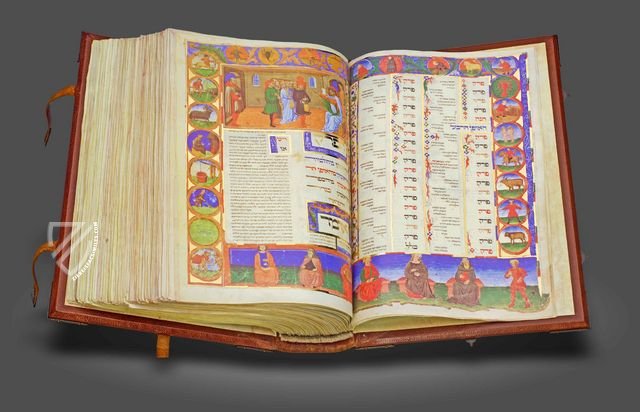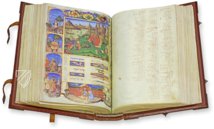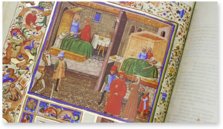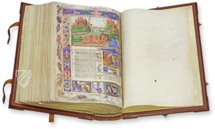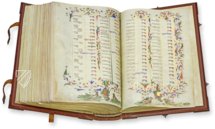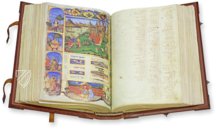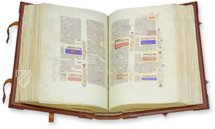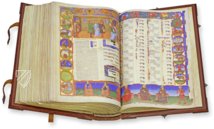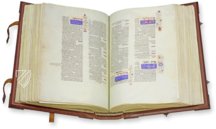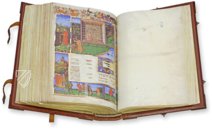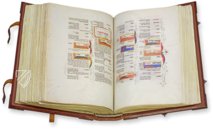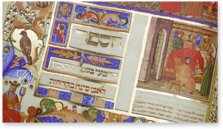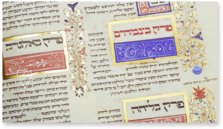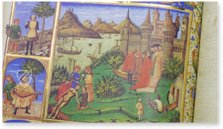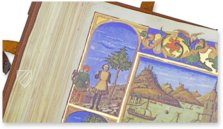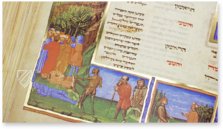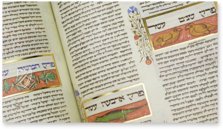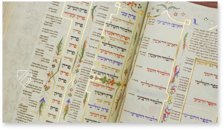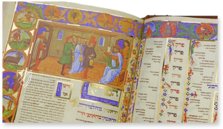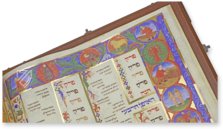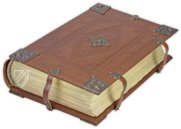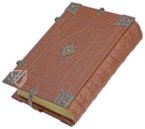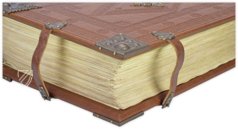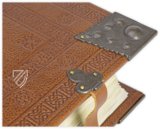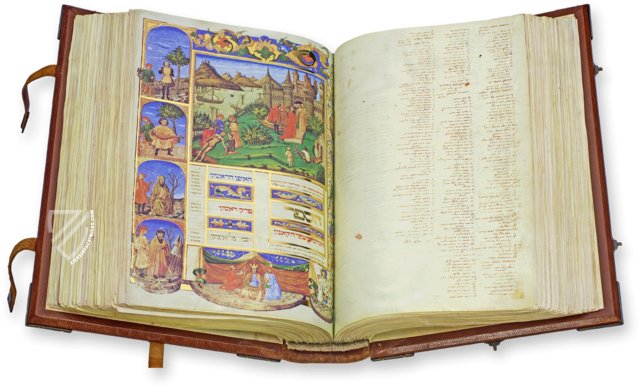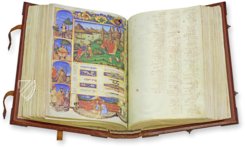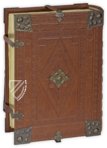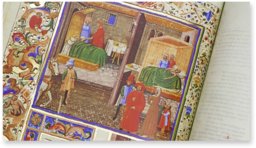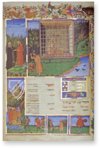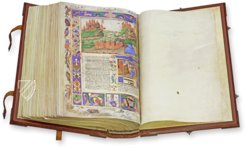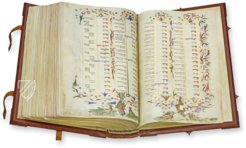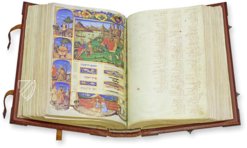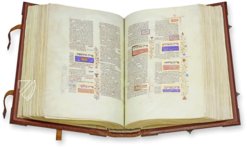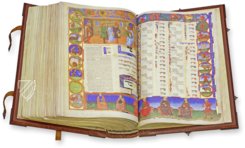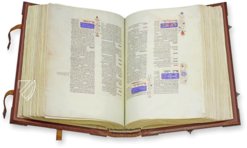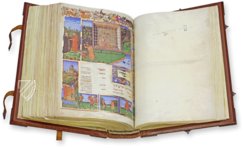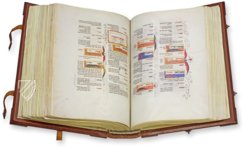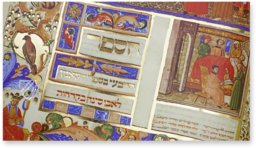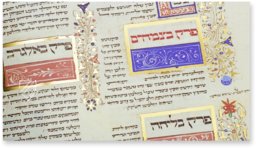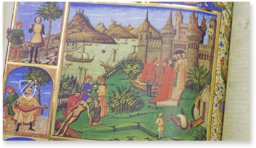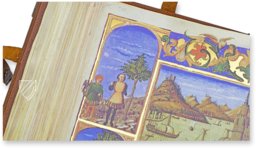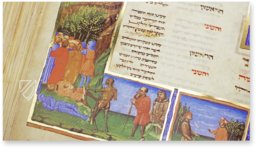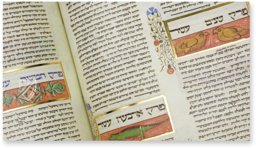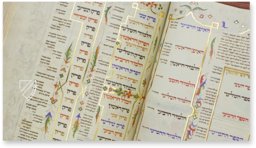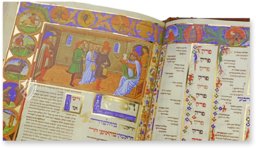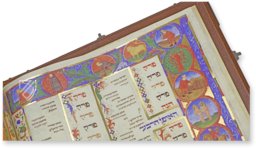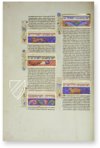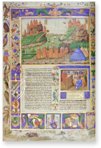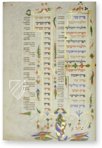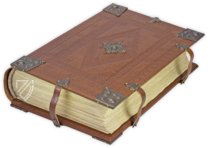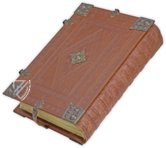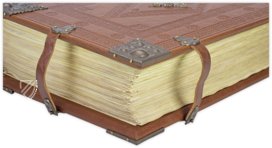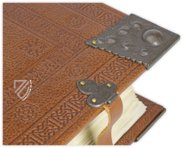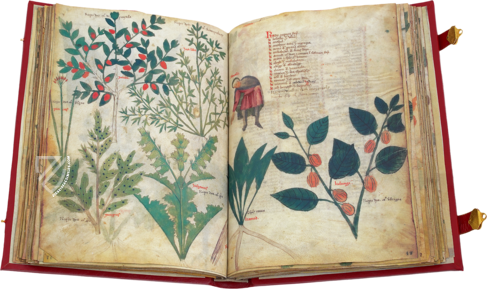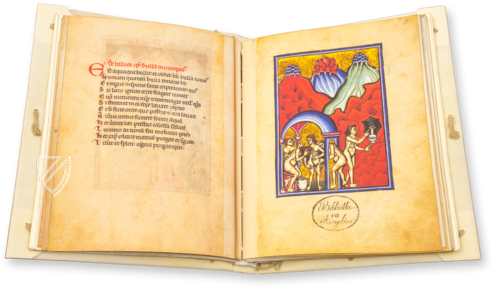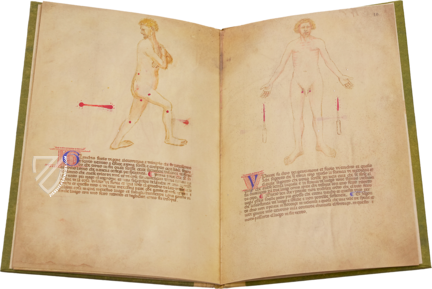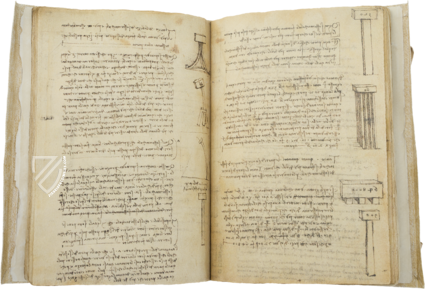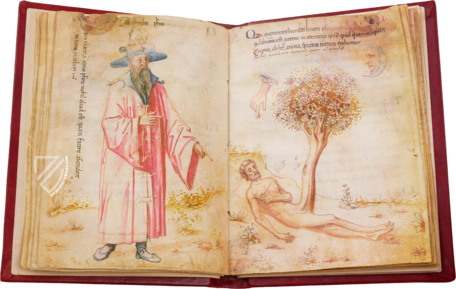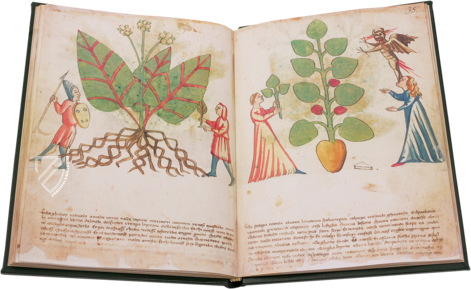Canon Medicinae Avicenna
(7,000€ - 10,000€)
The so-called Canon Medicinae is a Latin translation of an Arabic medical standard work. The original text was written ca. 1000 by the Persian Renaissance man Abū Alī al-Husain ibn Abdullāh ibn Sīnā and remained an absolute standard work of medicine until the 17th century. The edition at hand is a Latin translation of the masterpiece, which was made in Italy sometime in the first half of the 15th century. It is the most beautiful, unbelievably-charmingly-illustrated edition of this historically significant manuscript.
Canon Medicinae
The science of medicine has been practiced since the beginning of time and is constantly modernized with new findings. A whole series of medical manuscripts have been handed down to us, whose origins can sometimes be placed in antiquity. A handwritten codex, which is concerned with practical medicine, has had an immeasurable influence on the modern medicine of our time. It is the so-called Canon Medicinae, a medicinal treatise from the Middle East. This historically significant text remained a standard work of medical training throughout the Middle Ages and into the Early Modern Period. It was translated into Latin in the early 15th century and has been innumerably reproduced. Some editions of the medical treatise were furnished with captivating, colorful miniatures. In the first half of the 15th century, unbelievably talented artists in Italy made what is probably the most beautiful edition thereof.
A Persian Renaissance Man
The Canon Medicinae is the most famous work by Avicenna (Latinized), a Persian doctor, physicist, philosopher, poet, lawyer, mathematician, astronomer, alchemist, and music theorist. His full name is Abū Alī al-Husain ibn Abdullāh ibn Sīnā and he came from the historical region of Greater Khorasan, a region in Central Asia between northeast Iran and northwest Afghanistan in the area of the modern states of Afghanistan, Iran, Tajikistan, Uzbekistan, and Turkmenistan. Avicenna lived sometime between 980 and 1037 and is counted among the most famous personalities of his time. He measurably influenced the history and development of medicine in particular. A few of his philosophical treatises were later adopted by mystics of Sufiism. In the 12th century, the Canon Medicinae was first translated from Arabic into Latin by Gerhard of Cremona. The work, which already existed throughout the occident in some 15–20 Latin editions since 1470, was considered to be the most important medical textbook up until the 17th century.
The Standard Work of Medicine
The comprehensive manuscript is strictly divided into five groups of text. The sections address, in the following order, the general principles (theory of medicine), the alphabetical listing of medicines (remedies and their mode of action), illnesses, which only effect specific organs (pathology and therapy), illnesses, which spread to the entire body (surgery and general medicine), as well as the production of remedies (list of antidotes). In his work, Avicenna presented diagnoses, which dealt with the treatment of infectious and non-infectious diseases such as cancer or tuberculosis, clarified the influence of the climate and the environment on one’s health, correctly described the anatomy of the eyeball, and gave information about various medicines and anesthetics. Avicenna was not only the first scholar to establish rules for how a new medicine was to be tested before it was administered to a patient, he was the first to uncover the connection between the emotions of a person and their physical health, and stumbled upon the positive physical and psychological effects of music on patients. His service to modern medicine in this work is incomparable with any other.
A Rich Image Program
The edition before us of the comprehensive medical handbook was made during the first half of the 15th century in Italy. Unbelievably talented illuminators, who remain anonymous to this day, furnished the codex with a incredibly diverse image program. Ten pages of the manuscript are completely illuminated. They show scenes of various medical treatments, as performed by people in Italian garments and in typically Italian houses. The full-page miniatures are framed by fantastical, diversely-patterned bordure depictions in all forms and colors with richly-applied gold leaf. The elaborate book adornment continues across 498 pages of the manuscript. Small miniatures depicting motifs of plants and animals illustrate the informative medical text, which did not lose its significance for centuries.
Codicology
- Alternative Titles
- Avicenna's Canon of Medicine
Canon of Medicine
Kanon der Medizin
Das Meisterwerk des Medicus - Size / Format
- 1,064 pages / 43.5 × 30.5 cm
- Origin
- Italy
- Date
- First half of the 15th century
- Epochs
- Style
- Language
- Illustrations
- 10 full-page miniatures and 498 pages with floral and animal motifs
- Content
- Volume 1: Theoretical and practical basics of medicine and anatomy
Volume 2: 760 alphabetically arranged remedies from the plant kingdom
Volume 3: Diseases affecting the individual organs
Volume 4: Diseases affecting the whole body
Volume 5: Production an - Artist / School
- Abû Ali al Husaya Ibn Sīnā (Avicenna) (980–1037) (author)
Leonardo da Besozzo (illuminator)
Cristoforo Cortese (illuminator) - Previous Owners
- Dominican Monastery of Bologna
Bibliothèque nationale de France
Canon Medicinae Avicenna
Uroscopy
Examining a patient’s urine was the primary means of diagnosis for the medieval doctor, a practice known as a uroscopy. Medical manuscripts often contained a “urine wheel” with ca. 20 flasks arranged according to color with an explanation as to what illnesses might cause it. This doctor’s well-dressed patients wait in line with their urine sample to hear their diagnoses, which are announced publically. The first patient in black with red hat and pantyhose shows a clearly depressed and worried facial expression due to the diagnosis just received from the doctor.
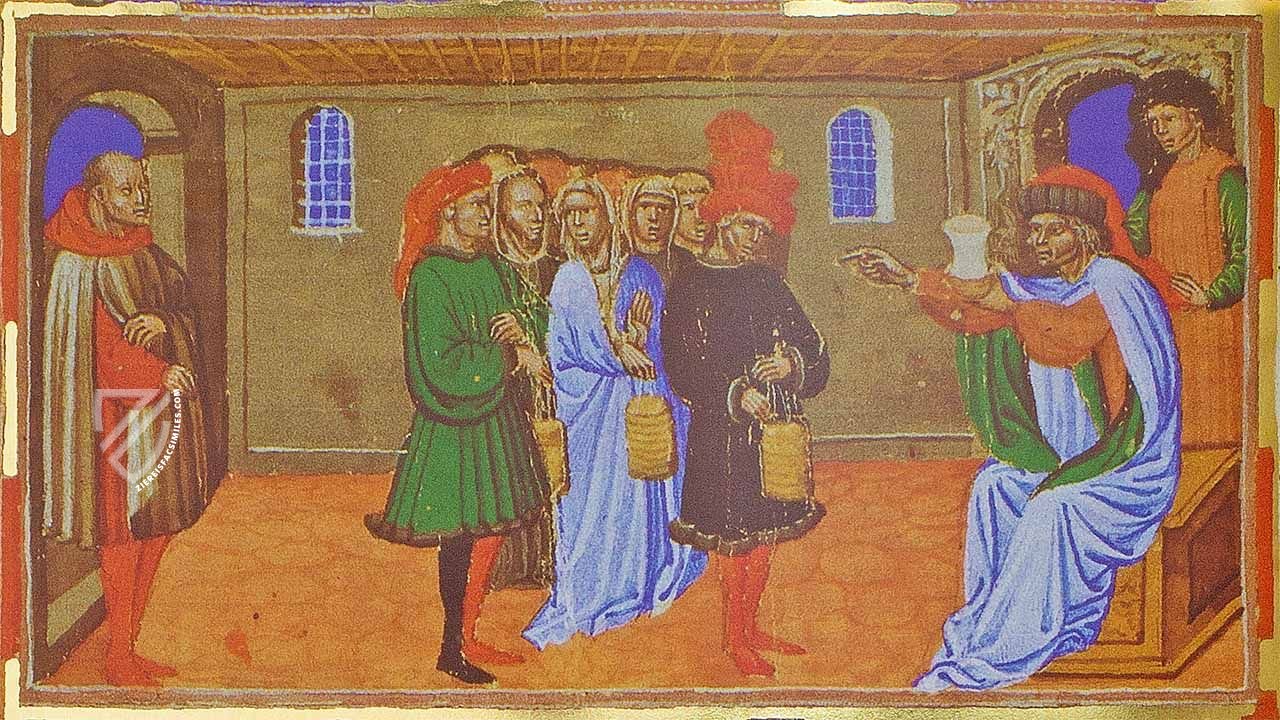
Canon Medicinae Avicenna
Treating Robert II of Normandy
According to legend, Duke Robert II of Normandy was wounded by a poisoned arrow in battle during the First Crusade. The primary miniature shows him on his return, when he stopped in Salerno, home of the first medical school in Western Europe, to receive treatment. The medieval southern Italian metropolis was regarded as one of the centres of European health education because of the application of ancient Greek and Roman medical knowledge combined with the influences of Arab and Jewish medicine.
The doctors advised Robert that the poison had to be sucked from his wound, but he refused because it would mean the death of whoever did it. However, his wife Sibylla decided to sacrifice her own life by sucking out the poison one night. She is the nude crowned figure being placed in a coffin as Robert, crowned and dressed in red, thanks the doctors for their help at the city gates.
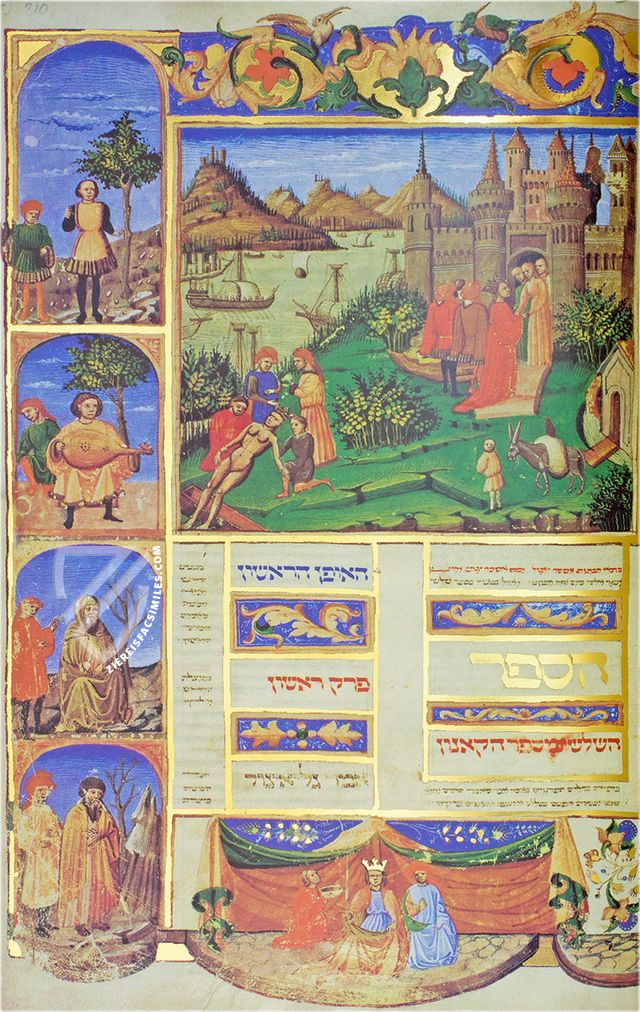
#1 Canon Medicinae
Languages: English, Spanish
(7,000€ - 10,000€)
- Treatises / Secular Books
- Apocalypses / Beatus
- Astronomy / Astrology
- Bestiaries
- Bibles / Gospels
- Chronicles / History / Law
- Geography / Maps
- Saints' Lives
- Islam / Oriental
- Judaism / Hebrew
- Single Leaf Collections
- Leonardo da Vinci
- Literature / Poetry
- Liturgical Manuscripts
- Medicine / Botany / Alchemy
- Music
- Mythology / Prophecies
- Psalters
- Other Religious Books
- Games / Hunting
- Private Devotion Books
- Other Genres
- Afghanistan
- Armenia
- Austria
- Belgium
- Belize
- Bosnia and Herzegovina
- China
- Colombia
- Costa Rica
- Croatia
- Cyprus
- Czech Republic
- Denmark
- Egypt
- El Salvador
- Ethiopia
- France
- Germany
- Greece
- Guatemala
- Honduras
- Hungary
- India
- Iran
- Iraq
- Israel
- Italy
- Japan
- Jordan
- Kazakhstan
- Kyrgyzstan
- Lebanon
- Liechtenstein
- Luxembourg
- Mexico
- Morocco
- Netherlands
- Palestine
- Panama
- Peru
- Poland
- Portugal
- Romania
- Russia
- Serbia
- Spain
- Sri Lanka
- Sweden
- Switzerland
- Syria
- Tajikistan
- Turkey
- Turkmenistan
- Ukraine
- United Kingdom
- United States
- Uzbekistan
- Vatican City
- A. Oosthoek, van Holkema & Warendorf
- Aboca Museum
- Ajuntament de Valencia
- Akademie Verlag
- Akademische Druck- u. Verlagsanstalt (ADEVA)
- Aldo Ausilio Editore - Bottega d’Erasmo
- Alecto Historical Editions
- Alkuin Verlag
- Almqvist & Wiksell
- Amilcare Pizzi
- Andreas & Andreas Verlagsbuchhandlung
- Archa 90
- Archiv Verlag
- Archivi Edizioni
- Arnold Verlag
- ARS
- Ars Magna
- ArtCodex
- AyN Ediciones
- Azimuth Editions
- Badenia Verlag
- Bärenreiter-Verlag
- Belser Verlag
- Belser Verlag / WK Wertkontor
- Benziger Verlag
- Bernardinum Wydawnictwo
- BiblioGemma
- Biblioteca Apostolica Vaticana (Vaticanstadt, Vaticanstadt)
- Bibliotheca Palatina Faksimile Verlag
- Bibliotheca Rara
- Boydell & Brewer
- Bramante Edizioni
- Bredius Genootschap
- Brepols Publishers
- British Library
- C. Weckesser
- Caixa Catalunya
- Canesi
- CAPSA, Ars Scriptoria
- Caratzas Brothers, Publishers
- Carus Verlag
- Casamassima Libri
- Centrum Cartographie Verlag GmbH
- Chavane Verlag
- Christian Brandstätter Verlag
- Circulo Cientifico
- Club Bibliófilo Versol
- Club du Livre
- CM Editores
- Collegium Graphicum
- Collezione Apocrifa Da Vinci
- Comissão Nacional para as Comemorações dos Descobrimentos Portugueses
- Coron Verlag
- Corvina
- CTHS
- D. S. Brewer
- Damon
- De Agostini/UTET
- De Nederlandsche Boekhandel
- De Schutter
- Deuschle & Stemmle
- Deutscher Verlag für Kunstwissenschaft
- DIAMM
- Droz
- E. Schreiber Graphische Kunstanstalten
- Ediciones Boreal
- Ediciones Grial
- Ediclube
- Edições Inapa
- Edilan
- Editalia
- Edition Deuschle
- Edition Georg Popp
- Edition Leipzig
- Edition Libri Illustri
- Editiones Reales Sitios S. L.
- Éditions de l'Oiseau Lyre
- Editions Medicina Rara
- Editorial Casariego
- Editorial Mintzoa
- Editrice Antenore
- Editrice Velar
- Edizioni Edison
- Egeria, S.L.
- Eikon Editores
- Electa
- Emery Walker Limited
- Enciclopèdia Catalana
- Eos-Verlag
- Ephesus Publishing
- Ernst Battenberg
- Eugrammia Press
- Extraordinary Editions
- Fackelverlag
- Facsimila Art & Edition
- Facsimile Editions Ltd.
- Facsimilia Art & Edition Ebert KG
- Faksimile Verlag
- Feuermann Verlag
- Folger Shakespeare Library
- Franco Cosimo Panini Editore
- Friedrich Wittig Verlag
- Fundación Hullera Vasco-Leonesa
- G. Braziller
- Gabriele Mazzotta Editore
- Gebr. Mann Verlag
- Gesellschaft für graphische Industrie
- Getty Research Institute
- Giovanni Domenico de Rossi
- Giunti Editore
- Graffiti
- Grafica European Center of Fine Arts
- Guido Pressler
- Guillermo Blazquez
- Gustav Kiepenheuer
- H. N. Abrams
- Harrassowitz
- Harvard University Press
- Helikon
- Hendrickson Publishers
- Henning Oppermann
- Herder Verlag
- Hes & De Graaf Publishers
- Hoepli
- Holbein-Verlag
- Houghton Library
- Hugo Schmidt Verlag
- Idion Verlag
- Il Bulino, edizioni d'arte
- ILte
- Imago
- Insel Verlag
- Insel-Verlag Anton Kippenberger
- Instituto de Estudios Altoaragoneses
- Instituto Nacional de Antropología e Historia
- Introligatornia Budnik Jerzy
- Istituto dell'Enciclopedia Italiana - Treccani
- Istituto Ellenico di Studi Bizantini e Postbizantini
- Istituto Geografico De Agostini
- Istituto Poligrafico e Zecca dello Stato
- Italarte Art Establishments
- Jan Thorbecke Verlag
- Johnson Reprint Corporation
- Josef Stocker
- Josef Stocker-Schmid
- Jugoslavija
- Karl W. Hiersemann
- Kasper Straube
- Kaydeda Ediciones
- Kindler Verlag / Coron Verlag
- Kodansha International Ltd.
- Konrad Kölbl Verlag
- Kurt Wolff Verlag
- La Liberia dello Stato
- La Linea Editrice
- La Meta Editore
- Lambert Schneider
- Landeskreditbank Baden-Württemberg
- Leo S. Olschki
- Les Incunables
- Liber Artis
- Library of Congress
- Libreria Musicale Italiana
- Lichtdruck
- Lito Immagine Editore
- Lumen Artis
- Lund Humphries
- M. Moleiro Editor
- Maison des Sciences de l'homme et de la société de Poitiers
- Manuscriptum
- Martinus Nijhoff
- Maruzen-Yushodo Co. Ltd.
- MASA
- Massada Publishers
- McGraw-Hill
- Metropolitan Museum of Art
- Militos
- Millennium Liber
- Müller & Schindler
- Nahar - Stavit
- Nahar and Steimatzky
- National Library of Wales
- Neri Pozza
- Nova Charta
- Oceanum Verlag
- Odeon
- Orbis Mediaevalis
- Orbis Pictus
- Österreichische Staatsdruckerei
- Oxford University Press
- Pageant Books
- Parzellers Buchverlag
- Patrimonio Ediciones
- Pattloch Verlag
- PIAF
- Pieper Verlag
- Plon-Nourrit et cie
- Poligrafiche Bolis
- Presses Universitaires de Strasbourg
- Prestel Verlag
- Princeton University Press
- Prisma Verlag
- Priuli & Verlucca, editori
- Pro Sport Verlag
- Propyläen Verlag
- Pytheas Books
- Quaternio Verlag Luzern
- Reales Sitios
- Recht-Verlag
- Reichert Verlag
- Reichsdruckerei
- Reprint Verlag
- Riehn & Reusch
- Roberto Vattori Editore
- Rosenkilde and Bagger
- Roxburghe Club
- Salerno Editrice
- Saltellus Press
- Sandoz
- Sarajevo Svjetlost
- Schöck ArtPrint Kft.
- Schulsinger Brothers
- Scolar Press
- Scrinium
- Scripta Maneant
- Scriptorium
- Shazar
- Siloé, arte y bibliofilia
- SISMEL - Edizioni del Galluzzo
- Sociedad Mexicana de Antropología
- Société des Bibliophiles & Iconophiles de Belgique
- Soncin Publishing
- Sorli Ediciones
- Stainer and Bell
- Studer
- Styria Verlag
- Sumptibus Pragopress
- Szegedi Tudomànyegyetem
- Taberna Libraria
- Tarshish Books
- Taschen
- Tempus Libri
- Testimonio Compañía Editorial
- Thames and Hudson
- The Clear Vue Publishing Partnership Limited
- The Facsimile Codex
- The Folio Society
- The Marquess of Normanby
- The Richard III and Yorkist History Trust
- Tip.Le.Co
- TouchArt
- TREC Publishing House
- TRI Publishing Co.
- Trident Editore
- Tuliba Collection
- Typis Regiae Officinae Polygraphicae
- Union Verlag Berlin
- Universidad de Granada
- University of California Press
- University of Chicago Press
- Urs Graf
- Vallecchi
- Van Wijnen
- VCH, Acta Humaniora
- VDI Verlag
- VEB Deutscher Verlag für Musik
- Verlag Anton Pustet / Andreas Verlag
- Verlag Bibliophile Drucke Josef Stocker
- Verlag der Münchner Drucke
- Verlag für Regionalgeschichte
- Verlag Styria
- Vicent Garcia Editores
- W. Turnowski Ltd.
- W. Turnowsky
- Waanders Printers
- Wiener Mechitharisten-Congregation (Wien, Österreich)
- Wissenschaftliche Buchgesellschaft
- Wissenschaftliche Verlagsgesellschaft
- Wydawnictwo Dolnoslaskie
- Xuntanza Editorial
- Zakład Narodowy
- Zollikofer AG

